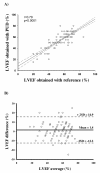Evaluation of a new pocket echoscopic device for focused cardiac ultrasonography in an emergency setting
- PMID: 22583539
- PMCID: PMC3580625
- DOI: 10.1186/cc11340
Evaluation of a new pocket echoscopic device for focused cardiac ultrasonography in an emergency setting
Abstract
Introduction: In the emergency setting, focused cardiac ultrasound has become a fundamental tool for diagnostic, initial emergency treatment and triage decisions. A new ultra-miniaturized pocket ultrasound device (PUD) may be suited to this specific setting. Therefore, we aimed to compare the diagnostic ability of an ultra-miniaturized ultrasound device (Vscan™, GE Healthcare, Wauwatosa, WI) and of a conventional high-quality echocardiography system (Vivid S5™, GE Healthcare) for a cardiac focused ultrasonography in patients admitted to the emergency department.
Methods: During 4 months, patients admitted to our emergency department and requiring transthoracic echocardiography (TTE) were included in this single-center, prospective and observational study. Patients underwent TTE using a PUD and a conventional echocardiography system. Each examination was performed independently by a physician experienced in echocardiography, unaware of the results found by the alternative device. During the focused cardiac echocardiography, the following parameters were assessed: global cardiac systolic function, identification of ventricular enlargement or hypertrophy, assessment for pericardial effusion and estimation of the size and the respiratory changes of the inferior vena cava (IVC) diameter.
Results: One hundred fifty-one (151) patients were analyzed. With the tested PUD, the image quality was sufficient to perform focused cardiac ultrasonography in all patients. Examination using PUD adequately qualified with a very good agreement global left ventricular systolic dysfunction (κ = 0.87; 95%CI: 0.76-0.97), severe right ventricular dilation (κ = 0.87; 95%CI: 0.71-1.00), inferior vena cava dilation (κ = 0.90; 95%CI: 0.80-1.00), respiratory-induced variations in inferior vena cava size in spontaneous breathing (κ = 0.84; 95%CI: 0.71-0.98), pericardial effusion (κ = 0.75; 95%CI: 0.55-0.95) and compressive pericardial effusion (κ = 1.00; 95%CI: 1.00-1.00).
Conclusions: In an emergency setting, this new ultraportable echoscope (PUD) was reliable for the real-time detection of focused cardiac abnormalities.
Figures

Comment in
-
Pocket ultrasound devices for focused echocardiography.Crit Care. 2012 Jun 29;16(3):134. doi: 10.1186/cc11386. Crit Care. 2012. PMID: 22748159 Free PMC article.
-
Is pocket ultrasound ready for prime time?Crit Care. 2012 Nov 14;16(6):436. doi: 10.1186/cc11827. Crit Care. 2012. PMID: 23151303 Free PMC article. No abstract available.
-
Learning to apply the pocket ultrasound device on the critically ill: comparing six 'quick-look' signs for quality and prognostic values during initial use by novices.Crit Care. 2013 Sep 4;17(5):448. doi: 10.1186/cc12875. Crit Care. 2013. PMID: 24004510 Free PMC article. No abstract available.
-
Authors' response.Crit Care. 2013;17(5):448. Crit Care. 2013. PMID: 25152953 No abstract available.
References
-
- American College of Emergency Physicians. Emergency ultrasound guidelines. Ann Emerg Med. 2009;53:550–570. - PubMed
-
- Beaulieu Y. Bedside echocardiography in the assessment of the critically ill. Crit Care Med. 2007;35:S235–249. doi: 10.1097/01.CCM.0000260673.66681.AF. - DOI - PubMed
-
- Price S, Via G, Sloth E, Guarracino F, Breitkreutz R, Catena E, Talmor D. Echocardiography practice, training and accreditation in the intensive care: document for the World Interactive Network Focused on Critical Ultrasound (WINFOCUS) Cardiovasc Ultrasound. 2008;6:49. doi: 10.1186/1476-7120-6-49. - DOI - PMC - PubMed
Publication types
MeSH terms
LinkOut - more resources
Full Text Sources
Medical

